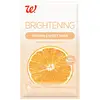What's inside
What's inside
 Key Ingredients
Key Ingredients

 Benefits
Benefits

 Concerns
Concerns

 Ingredients Side-by-side
Ingredients Side-by-side

Water
Skin ConditioningPropanediol
SolventSorbitol
HumectantTrehalose
HumectantDiglycerin
Humectant2-O-Ethyl Ascorbic Acid
Skin ConditioningHydroxyacetophenone
AntioxidantPhenoxyethanol
PreservativePolyglyceryl-6 Caprylate
EmulsifyingChlorphenesin
AntimicrobialYeast Extract
Skin ConditioningArginine
MaskingCarbomer
Emulsion StabilisingGlucose
HumectantButylene Glycol
HumectantSodium Hyaluronate
HumectantHydroxyethylcellulose
Emulsion StabilisingParfum
MaskingCitrus Reticulata Peel Extract
Skin ConditioningLeuconostoc/Radish Root Ferment Filtrate
AntimicrobialProline
Skin ConditioningWater, Propanediol, Sorbitol, Trehalose, Diglycerin, 2-O-Ethyl Ascorbic Acid, Hydroxyacetophenone, Phenoxyethanol, Polyglyceryl-6 Caprylate, Chlorphenesin, Yeast Extract, Arginine, Carbomer, Glucose, Butylene Glycol, Sodium Hyaluronate, Hydroxyethylcellulose, Parfum, Citrus Reticulata Peel Extract, Leuconostoc/Radish Root Ferment Filtrate, Proline
Water
Skin ConditioningDipropylene Glycol
HumectantGlycerin
Humectant1,2-Hexanediol
Skin ConditioningGlucose
Humectant3-O-Ethyl Ascorbic Acid
Skin ConditioningCaffeine
Skin ConditioningFerulic Acid
AntimicrobialCamellia Sinensis Leaf Extract
AntimicrobialCitrus Aurantium Dulcis Peel Oil
MaskingGlycyrrhiza Glabra Root Extract
BleachingCitrus Limon Fruit Extract
MaskingHippophae Rhamnoides Fruit Extract
Skin ConditioningNiacinamide
SmoothingSodium Hyaluronate
HumectantEthylhexylglycerin
Skin ConditioningXanthan Gum
EmulsifyingPolyglyceryl-4 Caprate
EmulsifyingPropanediol
SolventCellulose Gum
Emulsion StabilisingLimonene
PerfumingWater, Dipropylene Glycol, Glycerin, 1,2-Hexanediol, Glucose, 3-O-Ethyl Ascorbic Acid, Caffeine, Ferulic Acid, Camellia Sinensis Leaf Extract, Citrus Aurantium Dulcis Peel Oil, Glycyrrhiza Glabra Root Extract, Citrus Limon Fruit Extract, Hippophae Rhamnoides Fruit Extract, Niacinamide, Sodium Hyaluronate, Ethylhexylglycerin, Xanthan Gum, Polyglyceryl-4 Caprate, Propanediol, Cellulose Gum, Limonene
Ingredients Explained
These ingredients are found in both products.
Ingredients higher up in an ingredient list are typically present in a larger amount.
Glucose is a simple sugar and is the most important source of energy in all organisms.
In skincare, glucose is used to hydrate the skin. It also acts as a prebiotic for our natural biome.
Glucose is hydrating due to its humectant property. As a humectant, glucose draws moisture from the air and from deeper levels in the skin.
Our skin contains many sugars that act as prebiotics and help strengthen our natural microbiome. Having a healthy microbiome helps protect our skin from harmful bacteria and other contaminants.
Studies show glucose may help with fading discoloration and pigmentation. This is because our skin metabolizes glucose into lactic acid. Lactic acid is an AHA that helps exfoliate the top layer of skin.
Learn more about GlucosePropanediol is an all-star ingredient. It softens, hydrates, and smooths the skin.
It’s often used to:
Propanediol is not likely to cause sensitivity and considered safe to use. It is derived from corn or petroleum with a clear color and no scent.
Learn more about PropanediolSodium Hyaluronate is hyaluronic acid's salt form. It is commonly derived from the sodium salt of hyaluronic acid.
Like hyaluronic acid, it is great at holding water and acts as a humectant. This makes it a great skin hydrating ingredient.
Sodium Hyaluronate is naturally occurring in our bodies and is mostly found in eye fluid and joints.
These are some other common types of Hyaluronic Acid:
Learn more about Sodium HyaluronateWater. It's the most common cosmetic ingredient of all. You'll usually see it at the top of ingredient lists, meaning that it makes up the largest part of the product.
So why is it so popular? Water most often acts as a solvent - this means that it helps dissolve other ingredients into the formulation.
You'll also recognize water as that liquid we all need to stay alive. If you see this, drink a glass of water. Stay hydrated!
Learn more about Water